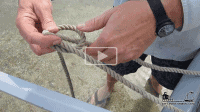Immediately after launching my boat this season, it became clear during the move from the Travelift to the dock that I had over looked preparing some simple, yet much needed dock lines. Luckily in this situation the boat yard was well equipped to assist, but not without a few pokes and prods at my boating ego regarding my slacked preparedness. I added making these lines to the to-do list and after some shopping around I discovered that I was looking at a couple hundred bucks to get the materials for what I needed…
At this point in the season I’m over budget and tying up the last odds and ends always proves to surprisingly expensive! Not to suggest that lines are something to skimp on, but without room in the budget I went down to a local indoor rock climbing gym and asked if they had any old rope they were willing to part with. Here I had my first real life experience of the old english idiom “money for old rope”. After a rope is used for a couple heavy falls it is deemed unsafe for humans to climb on, but still very capable of securing your boat! They were happy to contribute some rope to become line and this motivated me to find a great video on:
How to Eye Splice Double Braid Nylon Rope
Giving my new found line a new purpose required some rewarding splicing. It’s been great to follow along with the video and much easier then other diagrams and books that I’ve used in the past . After going back and watching this a few times I’m having great success! I purchased some Splicing Fids on Amazon and while the Fid sizes vary from those seen in the video, I’ve been able to use Andy Wall’s information to figure out the measurements needed. If you do find yourself acquiring old nylon line, be sure to determine whether it is Static or Dynamic. Unlike Static, Dynamic rope stretches. Which while desirable for some applications I would imagine a poor use for halyards.
Whether you’re an experienced rigger or a first time splicer, share your splicing experience and tricks in the comments below!
-Erik Sayce
Also See our Video on The Six Basic Boat Knots
. . . sign up to the right to get immediate access to this full post,
plus you'll get 10 of our best videos for free.
Get Free Videos& Learn More Join Now!!for Full Access Members Sign In



Michael Walker says:
My fids don’t have the short fid length marked. From measuring Mr. Wall’s fid length and short fid mark from the screen, I figure a ‘short fid’ length is 40% of full fid. I also discovered, I needed to drop down a fid diameter when working fid through cover with core inside. My starting fid seemed the right diameter, but just wouldn’t fit with cover/core and core altogether. Once I dropped down a fid size the splice went beautifully. My first successful solo eye splice!
Neal Carriker says:
I have been struggling with the very issue even with the advice from books directly addressing splicing I think with this video a few times I’ll be newly rigged at my cats traveler
Gregory Mactye says:
Erik – the Andy Wall video was pretty good, and I think if I watch it a few more times I should be able to duplicate the results. But why did Mr. Wall make such a small eye? I would think that that size would only be useful when including a thimble into the splice. My eyes (spliced in laid line) are all at least 9-inches long, as I use them to pass a girth hitch under and around the cleat’s horns on the boats I take care of at my dive team’s facility.
Thank you
Greg
David Tew says:
Erik, Speaking of not being prepared/forgetting something: Yesterday morning I hurried down to the dock to move our boat out to the mooring to make room for a neighbor who was coming in to load his big family for a day trip. After I tied up to the mooring I got into the dinghy which had been waiting patiently there overnight. I untied the painter and pushed off for the dock. Ooops. No oars. I forgot I I’d taken them ashore to tallow the leathers the night before. Fortunately the dock was dead downwind and I had the bailing scoop in the boat. So I pretended I was washing the boat as I floated in, gathering seawater water, sloshing it around the bilge, sponging and bailing it out from time to time… while ‘scooping’ myself into position to land. ;)
Erik Sayce says:
Haha! Thats great Dave, way to save face. I’m glad that I am not alone with these things.
Peter Brackenbury says:
That was quite remarkable to someone like me who had no clue how it was done. Thanks.